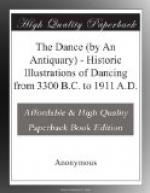That the Phoenicians and Greeks had at certain times immense influence on the Etruscans is evident from their relics which we possess (fig. 20).
A characteristic illustration of the dancer is from a painting in the tomb of the Vasi dipinti, Corneto, which, according to Mr. Dennis, [Footnote: “Etruria,” vol. i., p. 380.] belongs to the archaic period, and is perhaps as early as 600 B.C. It exhibits a stronger Greek influence than some of the paintings. Fig. 21, showing a military dance to pipes, with other sports, comes from the Grotta della Scimia, also at Corneto; these show a more purely Etruscan character.
[Illustration: Fig. 22.—Etruscan Dancing. From the Grotta del Triclinio.—Corneto.]
The pretty dancing scene from the Grotta del Triclinio at Corneto is taken from a full-sized copy in the British Museum, and is of the greatest interest. It is considered to be of the Greco-Etruscan period, and later than the previous examples (fig. 22).
There is a peculiarity in the attitude of the hands, and of the fingers being kept flat and close together; it is not a little curious that the modern Japanese dance, as exhibited by Mme. Sadi Yacca, has this peculiarity, whether the result of ancient tradition or of modern revival, the writer cannot say.
Almost as interesting as the Etruscan are the illustrations of dancing found in the painted tombs of the Campagna and Southern Italy, once part of “Magna Grecia”; the figure of a funeral dance, with the double pipe accompaniments, from a painted tomb near Albanella (fig. 23) may be as late as 300 B.C., and those in figs. 24, 25 from a tomb near Capua are probably of about the same period. These Samnite dances appear essentially different from the Etruscan; although both Greek and Etruscan influence are very evident, they are more solemn and stately. This may, however, arise from a different national custom.
That the Etruscan, Sabellian, Oscan, Samnite, and other national dances of the country had some influence on the art in Rome is highly probable, but the paucity of early Roman examples renders the evidence difficult.
[Illustration: Fig. 23.—Funeral dance in the obsequies of a female. From a painted tomb near Albanella.]
Rome as a conquering imperial power represented nearly the whole world of its day, and its dances accordingly were most numerous. Amongst the illustrations already given we have many that were preserved in Rome. In the beginning of its existence as a power only religious dances were practised, and many of these were of Etruscan origin, such as the Lupercalia, the Ambarvalia, &c. In the former the dancers were demi-nude, and probably originally shepherds; the latter was a serious dancing procession through fields and villages. [Illustration: Fig. 24.—Funeral dance. From Capua.]




